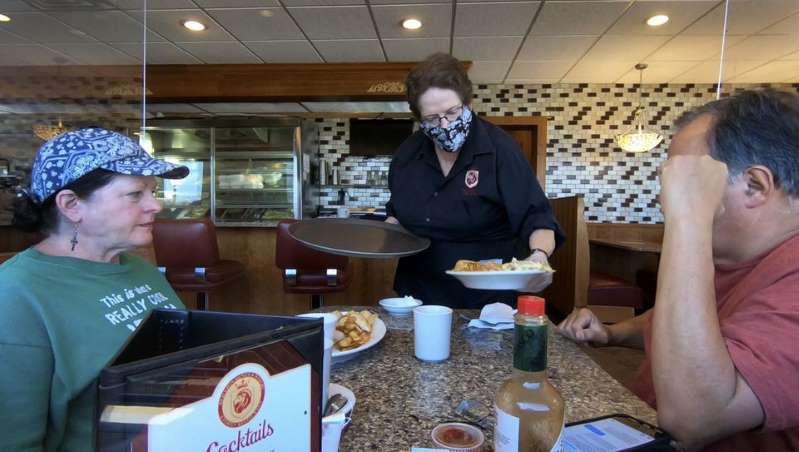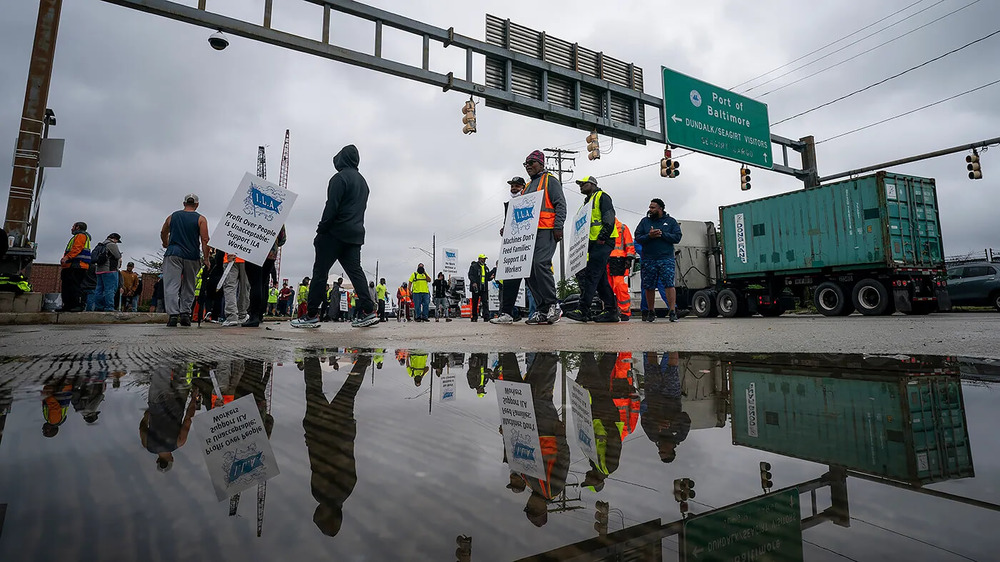Image © Michael Mancuso
Since before the state got the first coronavirus crisis under control, health experts and government officials have been warning of a second wave. They weren’t exactly sure when it would come, but they were sure that it would.
It now appears to be on the cusp of arrival. This week saw three straight days in which New Jersey reported more than 900 new cases of the coronavirus, and for the first time in two months, there are more than 700 hospitalizations for COVID-19 on Thursday and Friday.
Even though a handful of hotspot counties — including Ocean and Monmouth — have captured attention recently, Gov. Phil Murphy said the increase is statewide.
“There is only one way to get these numbers back down to where they were only a few weeks ago, and that is by doing the basics — wearing a face mask, by social distancing, and washing your hands frequently with soap and water,” the governor said at a news briefing Thursday. “As the weather cools, these numbers are not going to change themselves. Only we can change them.”
As terrifying as the possibility of another major coronavirus crisis is — it’s hard not to think of April, when hundreds of people in the state were dying every day from COVID-19 — there are some reasons to believe New Jersey will fare better this time around.
The main reason: Preparation.
“I think the state has all the systems in place,” said Perry Halkitis, the dean of the Rutgers University School of Public Health. “The question is are people going to do what they’re supposed to do.
“We have a knowledge base of seven months. We should be in better shape this time than last time.”
Think about it like this: As the first wave was spreading unchecked in early March, hardly anyone had masks, the state had no plans for testing and contact tracing, people were still packing onto NJ Transit trains and attending sporting events.
All of that has changed, along with just about everything else in our lives.
Even the government’s planned response to a second wave is different. Rather than a statewide, crippling shutdown, like happened in the spring, Murphy hopes to be more surgical.
While the Murphy administration did not respond to requests for further comment on its planned response to the second wave, the governor has spoken recently about his hesitancy to reimpose broad restrictions.
“I sure as heck hope we don’t and I do not anticipate it,” Murphy said a couple of weeks ago during a virtual town hall on Facebook Live. “I will be profoundly saddened and I will say shocked if we have to shut the whole place down again. I just don’t see that.”
As the state braces for the second wave, there’s a lot of apprehension. Could hospitals be overwhelmed? Schools shuttered again? Already struggling businesses dealt that final blow that pushes them under? Here are what key officials and experts say they expect as the state’s preparations over the past several months are tested.
Hospitals
Last spring, New Jersey’s hospital system was strained nearly to a breaking point as a flood of coronavirus patients threatened to drown ICUs.
As the chief medical and quality officer for the massive RWJBarnabas Health network, Dr. John Bonamo lived through those days. He remembers one evening, when the network had to rush ventilators from one hospital to another, to meet a surge of severely sick patients.
Talk of a second wave brings fears of a return to that crisis. But Bonamo said the hospital system is prepared to meet any new threat.
“Most of us in the field really do not believe we will see what we did then,” Bonamo said.
As COVID-19 ripped through the state, New Jersey’s hospitals added more than 1,000 ICU beds, going from 1,861 pre-coronavirus, to 3,100 in April, according to the New Jersey Hospital Association. Currently, there are about 2,350 ICU beds in place, but hospitals have maintained the infrastructure to bring others back quickly if needed, the association says.
Hospitals say they have been stockpiling personal protective equipment and have gotten better at treating the coronavirus. They’ve learned how to quickly screen patients who have COVID-19 and to keep them separate from the rest of the hospital’s population, unlike in the early days of the outbreak, when those patients and staff were mixed together.
Murphy has also said the state has been stocking up on protective equipment and certain treatments for the virus.
Drugs like remdesivir, steroids and blood-thinner medications, meanwhile, have shown promise in reducing the disease’s worst impacts. That also compares to the spring, when doctors were trying all kinds of treatments that ultimately proved ineffective, Bonamo said.
“Back in March and April, we were dealing with a disease that we didn’t really understand,” Bonamo said. “We had not seen a virus at this level of contagion in over 100 years. So we were, of course, unprepared.”
At state-owned University Hospital in Newark, officials say they are also ready for a new surge, even if it proved worse than what was seen in April, when hospitalizations statewide topped out at 8,084 coronavirus patients and 82% of the state’s intensive care beds were filled.
“Taking lessons learned, I think we are in a really good position this time,” said Dennis Boos, University Hospital’s director of emergency management.
Still, many nurses on the frontlines across New Jersey remain worried that there won’t be enough staff or that stores of personal protective equipment aren’t sufficient, said Barbara Rosen, the first vice president of the Health Professionals and Allied Employees union, which represents 14,000 health care workers.
During the height of the crisis, Rosen said, some nurses were forced to reuse masks for several days, hanging them on hooks when they left at the end of their shifts. While it has gotten better, “there still seems to be a supply issue throughout the state,” she said.
Kerry McKean Kelly, a spokeswoman for the New Jersey Hospital Association, said hospitals have spent the past several months rebuilding their stockpiles. They’ve beefed up their supply chains, which were reliant on overseas manufacturers, and have secured local vendors, she said.
RWJBarnabas Health, which includes 11 acute-care hospitals, has socked away three months worth of protective equipment at its central warehouse, Bonamo said. It has also put in orders with staffing companies to secure additional nurses, he said.
RWJBarnabas Health was treating 1,750 COVID-19 patients in its hospitals on April 13. At the time, New Jersey was announcing hundreds of coronavirus deaths each day, and the state was under a near lockdown.
Fast forward to Sept. 20, when RWJBarnabas recorded just 34 coronavirus patients, a low since the outbreak floored the state.
But those numbers have ticked back up again, and reached roughly 145 patients on Wednesday – a more than four-fold increase, but still far lower than before, Bonamo said.
Statewide, New Jersey’s 71 hospitals reported 728 coronavirus patients on Friday. That compares to much of September, when numbers were largely in the 400s.
Bonamo said that even so, the patient levels show that social distancing, hand washing and mask wearing has had an impact since the virus erupted.
“We hear constantly about people doing the wrong thing,” Bonamo said. “Yeah, they are out there and they are continuing, but so many people are doing the right thing.”
Schools
When school resumed this fall, public districts across New Jersey tried to walk a fine line between keeping their students and staff safe and offering the best education they could.
Some districts are all remote. Others are trying to make face-to-face instruction work. Many have embraced hybrid plans that combine the two by having some students learn virtually while others come to class.
A surge in coronavirus cases only makes that tightrope more difficult to balance, education experts said. With a second wave of the virus, they said, more districts will find themselves switching to virtual learning – though likely temporarily — as they respond to local or regional outbreaks by closing buildings.
That would produce new disruptions in education and prove difficult for working parents and those students most likely to be left behind with remote learning: those who live in poverty, have special needs or are learning the English language.
Education advocates say they expect closure decisions will be made district by district. Absent a crisis, they said they do not anticipate Murphy will issue the kind of sweeping statewide closure he imposed in March, though he might move to set regional limits if certain areas prove to be hotspots.
“Murphy has been really reluctant to make statewide decisions,” said Suzanne McCotter, the dean of The College of New Jersey’s education school. “He has really shown he wants to leave decisions to local control.”
That would continue the patchwork of responses that has already been seen since the new school year began, as districts close buildings temporarily — or delay reopening plans — after teachers or students test positive for the virus.
At least 16 New Jersey schools as of Thursday have confirmed coronavirus outbreaks in which students or teachers transmitted the disease to others in class or during extracurricular activities, according to the state. There were 58 cases linked to that spread.
Steve Baker, a spokesman for the New Jersey Education Association, said some teachers remain concerned whether their districts can safely offer in-person instruction. As cases rise, districts should err on the side of safety, he said.
“If we were giving it a progress report, we’d say we see some examples of good effort, and plenty of room for improvement,” Baker said.
Still, districts are much better prepared today than in March, when virtual learning was thrust upon them seemingly overnight, said Chris Cerf, a former state education commissioner and superintendent of Newark Public Schools.
“Last spring, districts all over the country were scrambling,” Cerf said. “They’ve now had six months to plan and think ahead about various contingencies.”
Teachers, students and parents have all gotten better at remote learning, even if it isn’t ideal.
“The teachers are ready to go into virtual learning if they have to, the students as well,” said Betsy Ginsburg, the executive director of the Garden State Coalition of Schools, which represents suburban districts across the state.
Richard Bozza, the executive director of the New Jersey Association of School Administrators, said districts appear to have secured the protective equipment that was in such short supply months ago.
“I’m not hearing the same concerns that I heard in August or even September,” Bozza said.
October marks a month when some school districts that opened all-remote are slated to transition to face-to-face instruction. Some aren’t taking that chance.
Among those was Deptford Township School District in Gloucester County, which decided to delay its planned reopening by nearly a month. Under Deptford’s new calendar, hybrid instruction will now begin Oct. 27 for special needs students, and other students will be brought in starting Nov. 10 and Nov. 16.
The delay comes as other districts in Gloucester County have reopened more quickly, only to have to switch to remote learning after students or teachers tested positive for COVID-19, said Sal Randazzo, Deptford’s communications coordinator.
“We’re just trying to avoid contributing to the spread in general,” Randazzo said.
Already, the district has had its own brush with coronavirus. Late last month, a member of one of the high school’s sports teams tested positive, forcing that individual to quarantine and the team’s practices to be canceled for two weeks, said Randazzo.
On Wednesday, the state’s fourth largest school district announced it also will continue all-remote learning. In delaying a return to classrooms until at least Jan. 19, Paterson Public Schools cited other Passaic County schools that were forced to suspend in-person instruction because of outbreaks, and noted that COVID-19 cases are only expected to increase.
Restaurants and other businesses
Walking past restaurant windows and seeing diners inside still feels strange, considering New Jersey went months without indoor dining.
And despite the uptick in coronavirus cases recently, restaurant owners and industry groups are pushing Murphy to expand capacity, some as a lifeline.
Marilou Halvorsen, president of the New Jersey Restaurant and Hospitality Association, said her members would like to see the regulations allow more than 50% capacity, up from the 25% currently permitted.
The governor said this week that he may increase restaurant capacity “sooner rather than later,” though he did not provide specifics. He also said that there does not appear to be evidence of coronavirus spreading from indoor dining.
“We think that responsibly, unless the roof falls in over the next number of days, we’re going to be able to get to a broader capacity there,” Murphy said.
New Jersey has been slower to lift restaurant restrictions than some neighboring states, and Murphy has been clear that if cases get out of control again, he will reimpose stricter measures.
Halvorsen said that until the governor acts, diners should expect more of what they’ve seen over the past couple of months: outdoor dining in tents, spaced-out tables inside and servers in masks.
But even the continuation of outdoor dining has raised questions in the state, particularly with cold weather on the horizon. The obvious solution is installing heaters in outdoor areas, something the state has endorsed. But Halvorsen said that some towns have pushed back on the heaters, further limiting options for restaurants.
Few businesses have faced as much pressure during the pandemic as restaurants, and any additional restrictions imposed because of the second wave could prove ruinous.
“It would be catastrophic,” Halvorsen said.
“We’re already looking in the neighborhood of 37% to 42% of restaurants either not reopening or closing by the end of the year as it is,” she added, citing a national figure for the restaurant industry.
Conditions for small businesses other than restaurants have improved in recent months, despite manifold challenges, said Deborah Smarth, associate state director of the New Jersey Small Business Development Center.
Businesses that have been the most nimble, both in terms of moving sales online and adjusting their marketing strategies, have had the most success, she said. Smarth said her organization has helped small businesses in the state obtain coronavirus relief money and has put on webinars on how companies can survive the pandemic.
“Right now we’re in recovery. This is the initial stage of recovery,” Smarth said. “Things have gotten better, but there’s a lot more to do.”
She then threw in a huge caveat on her “cautious optimism” about business conditions. We expect to keep improving “unless there’s a major wave.”
The unknown
That’s the one big note of caution, experts underscore. The future is, after all, yet to be written and the breadth and strength of a second wave remains an unknown.
Pandemic fatigue is setting in, as is the colder weather — and with it, the holidays that draw people together. Epidemiologists stress the importance of wearing masks and adhering to social distancing guidelines, but worry whether people will be willing to continue those small but vital precautions to limit the impact of the disease’s reemergence.
“Our destiny is in our hands. People should ask themselves, ‘Do I need to place myself or the people in my life at risk?’” said Halkitis, the dean of Rutgers’ School of Public Health. “The government can only do so much. At the end of the day, we’ve got to work with the government.”
This article originally appeared on msn.com:



















